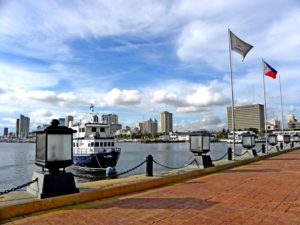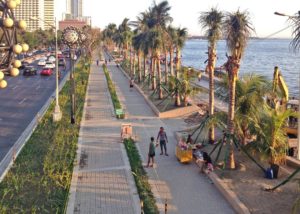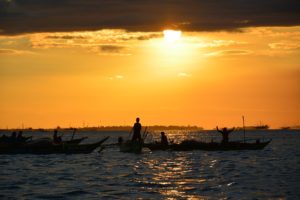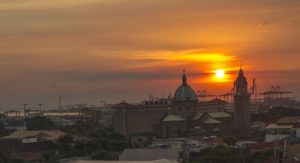 The capital city of the Philippines, Manila, is a vibrant and interesting destination. A must-visit, if history and culture are of any worth to you and exploring new ways of living fascinates you. Manila is the second most populated city in the Philippines with a population of 1,652,171. The city is just under 15 square miles, making it the most densely populated city, not only in the Philippines, but also in the entire world, giving it an edge that nobody should miss if given the chance.
The capital city of the Philippines, Manila, is a vibrant and interesting destination. A must-visit, if history and culture are of any worth to you and exploring new ways of living fascinates you. Manila is the second most populated city in the Philippines with a population of 1,652,171. The city is just under 15 square miles, making it the most densely populated city, not only in the Philippines, but also in the entire world, giving it an edge that nobody should miss if given the chance.
Manila’s original streets, its deep and captivating history, its rich culture, and its friendly people area all major aspects which will make the average visitor leave in awe.
 The earliest known records of the lively city of Manila date back to as late as the tenth century. It was once known as the “Pearl of the Orient” due to its strategic location in the Pacific as a major important trade route. Although the city suffered incredibly devastating destruction during World War II, it has since, been rebuilt and modernised in many aspects, keeping the rich history and culture in some of its architecture. Today, Manila is the centre of education of the country, is hosts headquarters to the World Health Organization Regional Office for the entire Western Pacific, and attracts an incredible sum of roughly one million tourists every year.
The earliest known records of the lively city of Manila date back to as late as the tenth century. It was once known as the “Pearl of the Orient” due to its strategic location in the Pacific as a major important trade route. Although the city suffered incredibly devastating destruction during World War II, it has since, been rebuilt and modernised in many aspects, keeping the rich history and culture in some of its architecture. Today, Manila is the centre of education of the country, is hosts headquarters to the World Health Organization Regional Office for the entire Western Pacific, and attracts an incredible sum of roughly one million tourists every year.
 Manila has two international airports and a Light Rail Transit System of 11 different train stations situated on ground level. There are several modes of transport in the city, there are taxis, motorcycles with sidecars known as tricycles, and the most popular form of transportation, which is known as ‘jeepneys”, which are jeep-like public utility vehicles. This method of transportation has its roots from World War II with the surplus jeeps that were sold to the Philippines who cleverly painted them in bright native colours and began using them and producing them for family and tourist transportation.
Manila has two international airports and a Light Rail Transit System of 11 different train stations situated on ground level. There are several modes of transport in the city, there are taxis, motorcycles with sidecars known as tricycles, and the most popular form of transportation, which is known as ‘jeepneys”, which are jeep-like public utility vehicles. This method of transportation has its roots from World War II with the surplus jeeps that were sold to the Philippines who cleverly painted them in bright native colours and began using them and producing them for family and tourist transportation.
One of the most popular activities to carry out in Manila is an international all-time favourite- Shopping. Shopping is extremely popular in Manila. The city’s largest and most popular mall is Robinson’s Place Manila, a shopping mall with seven levels that contains over 330 trendy and well equipped shops, mouth-watering restaurants and fun entertainment facilities to keep one busy all day.
 Other attractions include Rizal Park also known as Luneta, which is the most important shrine in the country, as well a great place to watch the locals spend their weekend. Settle down on a colorful picnic mat or buy a kite. Luneta is conveniently located exactly in the middle of the city. There tourists can enjoy the Museum of the Filipino People also known as the National Museum, which holds the most extensive and important exhibit of Galleon Trade relics in the Philippines and illustrates the origins of the Filipino people. But even without stepping inside, the National Museum itself is a work of art and an incredible example of the beauty in Neo-Classical architecture. Other culture and history oriented activities include visits to the National Library of the Philippines, the beautiful green and refreshing Japanese Garden at Rizal Park, and the Rizal Monument itself which is a must see while in Manila.
Other attractions include Rizal Park also known as Luneta, which is the most important shrine in the country, as well a great place to watch the locals spend their weekend. Settle down on a colorful picnic mat or buy a kite. Luneta is conveniently located exactly in the middle of the city. There tourists can enjoy the Museum of the Filipino People also known as the National Museum, which holds the most extensive and important exhibit of Galleon Trade relics in the Philippines and illustrates the origins of the Filipino people. But even without stepping inside, the National Museum itself is a work of art and an incredible example of the beauty in Neo-Classical architecture. Other culture and history oriented activities include visits to the National Library of the Philippines, the beautiful green and refreshing Japanese Garden at Rizal Park, and the Rizal Monument itself which is a must see while in Manila.
Metro Manila consists of many other surrounding cities, including Pasay, Paranaque, Mandaluyong, Makati, Taguig, Pasig, Quezon City, and more. And it is conveniently within just a one to two hours’ drive from other cities such as Cavite City, Tagaytay, Botangas, and even Angeles City.
 The richness in history and culture does not end there. When the Spaniards arrived in the 1500’s, they built a walled city in place of the kuta (fort) of Rajah Soliman. This city is now known as Intramuros, one of the best models of an incredibly astounding medieval fort outside Europe. Intramuros contains the UNESCO World Heritage Site of the San Agustin Church and the San Agustin Museum. The compound contains fine religious artifacts and relics from the Galleon Trade. One can find everything, from treasure chests to ivory saints to beautifully embroidered gold vestments. In addition, Juan Luna, one of the greatest Filipino painters in history, is buried here.
The richness in history and culture does not end there. When the Spaniards arrived in the 1500’s, they built a walled city in place of the kuta (fort) of Rajah Soliman. This city is now known as Intramuros, one of the best models of an incredibly astounding medieval fort outside Europe. Intramuros contains the UNESCO World Heritage Site of the San Agustin Church and the San Agustin Museum. The compound contains fine religious artifacts and relics from the Galleon Trade. One can find everything, from treasure chests to ivory saints to beautifully embroidered gold vestments. In addition, Juan Luna, one of the greatest Filipino painters in history, is buried here.
 Casa Manila, a lifestyle museum replicated from an 1800’s home, is also in the area. The guards and the owners of the horse-drawn carriages are dressed in period costumes for keep tourists to take selfies and candids with them. The Philippines’ very first hotel established all the way back in 1912 is also located in Intramuros. The Manila Hotel is far off from shy of impressing with its grandeur, classic atmosphere, and historical value, having hosted famous and influential personalities like Gen. Douglas MacArthur, Marlon Brando, and even music history’s best; The Beatles.
Casa Manila, a lifestyle museum replicated from an 1800’s home, is also in the area. The guards and the owners of the horse-drawn carriages are dressed in period costumes for keep tourists to take selfies and candids with them. The Philippines’ very first hotel established all the way back in 1912 is also located in Intramuros. The Manila Hotel is far off from shy of impressing with its grandeur, classic atmosphere, and historical value, having hosted famous and influential personalities like Gen. Douglas MacArthur, Marlon Brando, and even music history’s best; The Beatles.
In the historic streets of Binondo, tourists can taste their way through Chinatown, which is said to be the oldest Chinese settlement in the world, established in the late 16th century. Here, tourists can have a sampling of delicious authentic Fujian and Cantonese cuisine and enjoy the authenticity of the surrounding streets of the restaurants with street vendors of dragon fruits, mangoes and other tropical fruits at amazing bargainable prices.
Which brings us to talk about one of the seven wonders of life: food. The street food in Manila can probably be considered some of the best around the globe. Some of the common delicacies include Siomai, a dumpling type of food, Sinigang, a sour broth made with Tamarind, meat and leafy vegetables and one of Philippines’ most famous, chicken Adobo, which uses a creative combination of vinegar and soy sauce to flavour the meat. Whether it be in the streets, in a cosy restaurant or a luxurious hotel, Manila’s cuisine will not disappoint.
 Sunsets in Manila Bay must not be missed out. Although it may seem somewhat of a cliché, a walk down Roxas Boulevard while the sun sets will not disappoint. And after the picturesque moments walking down the mesmerizing bay, one is sure to be ready for night life in Manila. Malate, an area nearby is sure to bring memorable nights in all the pubs, clubs and unusually decorated bars.
Sunsets in Manila Bay must not be missed out. Although it may seem somewhat of a cliché, a walk down Roxas Boulevard while the sun sets will not disappoint. And after the picturesque moments walking down the mesmerizing bay, one is sure to be ready for night life in Manila. Malate, an area nearby is sure to bring memorable nights in all the pubs, clubs and unusually decorated bars.
And to top it off, if the big shopping malls, the street vendors, the big whiff of culture and history and the delicious food are not enough, after walking a few blocks, one can reach Divisoria, a wholesaler’s haven, where increased quantity means decreased rates. So the more you buy, the cheaper it gets.
 The history, the culture, the shopping, and all the fun activities make Manila a perfect destination for couples, friends, families and even lone-riders. However, what makes Manila and the Philippines in general a beautiful place is its people. While meandering down Manila’s little side streets one can find not only delicious and authentic street food in an ahawan (hawker-style grill), but may on more than one occasion encounter a friendly Manileño ready to share family stories, adventures and simple day to day routine things with the average tourist. So, what makes Manila a striking city, other than its rich culture and history, its palette friendly delicacies and the crazy amounts of shopping one can carry out in the city, is its outgoing people with their community oriented vibes who try to always be as resourceful as possible and their genuine inviting smiles that are always ready to help in whatever way possible, demonstrating hospitality unlike in any other city. Let us not forget that the average Manileño speaks near to perfect English, therefore communicating and getting to know the locals is a more than easy task when the locals themselves make sure to be open and welcoming to tourists from all over the world.
The history, the culture, the shopping, and all the fun activities make Manila a perfect destination for couples, friends, families and even lone-riders. However, what makes Manila and the Philippines in general a beautiful place is its people. While meandering down Manila’s little side streets one can find not only delicious and authentic street food in an ahawan (hawker-style grill), but may on more than one occasion encounter a friendly Manileño ready to share family stories, adventures and simple day to day routine things with the average tourist. So, what makes Manila a striking city, other than its rich culture and history, its palette friendly delicacies and the crazy amounts of shopping one can carry out in the city, is its outgoing people with their community oriented vibes who try to always be as resourceful as possible and their genuine inviting smiles that are always ready to help in whatever way possible, demonstrating hospitality unlike in any other city. Let us not forget that the average Manileño speaks near to perfect English, therefore communicating and getting to know the locals is a more than easy task when the locals themselves make sure to be open and welcoming to tourists from all over the world.
All of these aspects of this charming city make it one of the most loved in Southeast Asia. If you have not been to Manila yet, it is about time for you to go.


